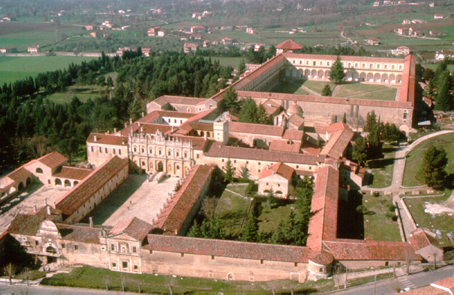
| :. Intro | ||
| :. Castelcivita grottoes | ||
| :. Castellabate | ||
|
||
|
||
|
||
|
||
| :. Paestum | ||
| :. Padula Charterhouse | ||
| :. Palinuro | ||
| :. Velia | ||
|
----
|
||
|
----
|
||
| :. Typical food products | ||
| :. Diving in Cilento | ||
| :. Public transportation | ||
| :. Maps | ||
| :. Email us |
|
Padula is a well-known place thanks to the Charterhouse of San Lorenzo, grand monument of the South of Italy. The “certosini” monks are the members of the monastic order founded by S. Bruno in 1084 AC. Their name derive from the Charterhouse (certosa in Italian) that, in turn, derived its name from the first building, the Chartreuse, located in Grenoble, France. The holy writ, approved during the XII century, is based on Benedictine inspiration and comprehends recluse life, prayer, study and work. The construction of the first nucleus of the Charterhouse began on January 28th 1306 and during the centuries it reached the huge size that you can actually admire. The Charterhouses plants were always the same in every country they were built, because of the strict enactment of the original holy writ. Therefore, the plant design is always the same despite the magnitude, richness and perfection of each one. |
|
|
|
The Charterhouse consists in two areas: the “low house” and the “high house”. The first one comprehends the work places (storage, tithe barns, stables, laundry, at al.); the second one is the monks’ residence where the silence and the strict isolation predominate. This clear separation well reflects all the monastic group demands. This group, in fact, consisted in monks who live upstairs in strict isolation and other monks who live downstairs and take care of all the activities and necessities of the Charterhouse. The “Certosini” monks lived there up to the 1866 when they definitely leaved the Charterhouse that became National Monument in 1882. The Padula Charterhouse facade is baroque, as well as the internal, with its carved choirs and valuable altar. The big cloister is a huge rectangle, with a two-order portico of 84 arches, adorned by a central fountain. The “certosini” monks used to spend most part of the day into their cell, praying, studying and devoting to meditation in a perennial search of God. The cells are usually comfortable and homely: after the entry there is a corridor, a bedroom and a living room with a fireplace and outside every cell has a covered lodge and a vegetable garden where the fathers spent the first evening hours. Near the front door there was, in every cell, the “clausura” wheel that was used by the monk in isolation to receive the food or everything else they needed. The library, recently restored, is also very suggestive. The library was a very important place for every monk: the study, with the prayer and the work, was fundamental to raise the soul and strengthen the doctrine. The Library entrance is near to the prior cell; just entered, you can see one of the most beautiful works of the entire Charterhouse: a helicoidal 38 monolithic steps staircase that opens as a fan and leads to the Library hall. It is a stone staircase with a riddle derived from the same steps and that go up creating a stone balustrade. The author of this beautiful monument that probably was built during the XV century is still unknown. The San Lorenzo a Padula Charterhouse has been recognized as part of the Unesco World Heritage since 1998. |
